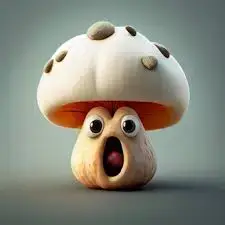
Calling all foodies and mushroom connoisseurs! Today, we’re going on a gastronomic adventure to discover the fascinating world of dried mushrooms. These flavor-packed gems are prized for their capacity to improve dishes, and in this article, we’ll reveal the methods of keeping them fresh and delicious. Prepare to be amazed by the delights of dried mushrooms and to elevate your culinary creations to new heights!
Section 1: Identifying Expired or Bad Mushrooms
Recognizing Spoilage Signs: Dried mushrooms are culinary jewels, but recognizing when they’ve gone bad is critical for a safe and satisfying cooking experience. Here are some significant factors to keep an eye out for:
- Discoloration: If the mushroom’s color has significantly changed, especially if it appears darker or has turned brownish, it may be past its peak.
- Slimy Texture: Healthy dried mushrooms should feel firm and dry to the touch. If they seem slimy or mushy, it’s a clear sign of spoilage.
- Unpleasant Smell: Fresh mushrooms emit an earthy, pleasant aroma. If they release a sour, unpleasant, or off-putting smell, they might have gone bad.
- Mold Growth: Visible mold patches on the mushroom’s surface are a definitive sign of spoilage and should prompt immediate disposal.
- Wrinkling or Shrinking: Expired mushrooms may become wrinkled or shriveled, indicating a loss of moisture and freshness.
- Unusual Spots or Blemishes: Inspect the mushroom’s surface for any unusual spots, bruises, or blemishes, as they could be signs of decay.
- Slimy Gills: If the gills (the ridges under the cap) of the mushroom appear slimy, it’s a clear indication of spoilage.
Always trust your instincts and senses when assessing the freshness of mushrooms. When in doubt, it’s safer to err on the side of caution and discard any mushrooms that seem questionable. Enjoy your mushrooms at their peak to savor their delightful flavors!
Section 2: Finding the Packaging Date
Discovering the Packaging Date: Determining the packaging date of your dried mushrooms can provide valuable insights into their freshness. While not all packages explicitly state the packaging date, here are several methods to uncover this information:
- Check the Label: Some mushroom packages include a “best before” or “use by” date, which can offer an approximate idea of when they were packaged. Keep in mind that this date refers to the recommended consumption period, not necessarily the packaging date.
- Look for Batch Codes or Stamps: Certain mushroom producers use batch codes or stamps on the packaging to indicate the date of packaging. These codes may comprise a combination of numbers or letters, representing the day, month, and year of packaging.
- Contact the Producer: If you’re unable to find the packaging date on the label, consider reaching out to the mushroom producer or the store where you purchased them. They might have access to additional information about the product.
- Observe the Appearance: Although not a precise method, examining the mushrooms’ appearance can provide a rough estimate of their freshness. Fresh mushrooms should be plump, firm, and free from discoloration or signs of spoilage.
Keep in mind that mushrooms are perishable, and their freshness can decline over time. If you’re uncertain about the packaging date or suspect that the mushrooms may be expired, it’s best to err on the side of caution and use fresher mushrooms for your culinary creations.
Section 3: How Long Do Dried Mushrooms Last?
Hey there, fellow mushroom lovers! Ever wondered how long those dried mushrooms can hang around? Well, fret not! Here’s the scoop: dried mushrooms have a shelf life ranging from approximately six months to two years. Not too shabby, right?
Now, let’s ensure these fungi stay happy and flavorful! Store them in airtight containers in a cool, dry spot, away from direct sunlight. No need for dramatic farewells, but if they emit an unusual smell or display mold, it’s time to bid them adieu.
But hey, let’s not say goodbye just yet! Dried mushrooms are culinary gems! Soak ’em, cook ’em, and brace yourself for a flavor explosion. Whether in soups, stews, pasta, risotto, or countless other dishes, they have the power to transform your meals from good to gourmet in a heartbeat.
So, my fellow foodies, stock up on those dried mushrooms and get ready to elevate your culinary game! Happy cooking!
Section 4: The Average Shelf Life of Mushrooms
The average shelf life of fresh mushrooms varies depending on the type of mushroom and how they are stored. Typically, most fresh mushrooms can last anywhere from seven to ten days under proper storage conditions.
Here are some tips to extend the shelf life of fresh mushrooms:
- Refrigeration: Store fresh mushrooms in a paper bag or a perforated plastic bag in the refrigerator’s vegetable drawer. Avoid sealing them in airtight containers, as they require some air circulation.
- Avoid Moisture: Mushrooms are sensitive to moisture, so refrain from washing them until you’re ready to use them. Excess moisture can promote spoilage.
- Inspect for Spoilage: Regularly check the mushrooms for any signs of mold, sliminess, or discoloration. Discard any mushrooms that exhibit signs of spoilage.
- Use Clear Plastic Wrap: If you purchased pre-packaged mushrooms wrapped in plastic, consider replacing the wrap with a clean, breathable plastic or a paper bag for better storage.
Keep in mind that wild-foraged mushrooms may have a shorter shelf life compared to cultivated varieties. As for dried mushrooms, as mentioned earlier, they can last anywhere from six months to two years when stored properly in cool, dry, and airtight containers.
Always rely on your senses when assessing the freshness of mushrooms. When they begin to appear and smell off, it’s time to either use them promptly or bid them farewell. Proper storage and timely consumption ensure that you get the best out of these delightful fungi!
Section 5: Best Ways to Properly Store Dried Mushrooms
Hey there, fellow mushroom enthusiasts! Let’s delve into the art of keeping those dried wonders fresh and bursting with flavor. Here are the best methods for storing dried mushrooms:
- Airtight Containers: Seal the deal with airtight containers like mason jars or vacuum-sealed bags. This will keep moisture and pesky bugs at bay.
- Cool and Dry: Find a cool, dry spot in your kitchen or pantry to store these containers. Humidity is not their friend!
- No Sunlight: Mushrooms prefer to stay out of the spotlight. Keep them away from direct sunlight to preserve their quality.
By following these simple tips, your dried mushrooms will always be ready to work their culinary magic in your dishes whenever you need them. Happy cooking!
Section 6: How to Use Dried Mushrooms in Almost Anything
Using dried mushrooms in your cooking can elevate nearly any dish to a whole new level of flavor and depth. Here are some fantastic ways to incorporate these culinary wonders into your recipes:
- Broths and Soups: Add a handful of dried mushrooms to your broth or soup base for a rich and earthy flavor. As they rehydrate during cooking, they infuse the liquid with their delicious essence.
- Sauces and Gravies: Whether you’re preparing a hearty pasta sauce or a savory gravy, dried mushrooms can be your secret weapon. Simply rehydrate them and toss them into the mix for an extra burst of umami goodness.
- Stir-Fries and Sautéed Dishes: Sauté rehydrated mushrooms with garlic and onions as a delectable base for your stir-fries and other sautéed creations.
- Risottos and Pilafs: Dried mushrooms are a match made in culinary heaven with creamy risottos and flavorful pilafs. They bring depth and complexity to these rice dishes that will impress any palate.
- Omelets and Frittatas: Sprinkle rehydrated mushrooms into your morning omelets or frittatas for a savory kick to start your day on a delicious note.
- Burger Patties: Blend finely chopped dried mushrooms into your burger patties to enhance the taste and make them juicier.
- Stuffings and Casseroles: Incorporate rehydrated mushrooms into stuffings and casseroles to take them from ordinary to extraordinary.
- Pizzas and Flatbreads: Sprinkle dried mushrooms over your favorite pizzas and flatbreads for an extra burst of flavor.
- Dips and Spreads: Blend rehydrated mushrooms into creamy dips and spreads for a delightful twist on classic recipes.
- Pastas and Noodles: Toss some rehydrated mushrooms into your pasta or noodle dishes for a gourmet touch that will have your taste buds dancing.
Remember, the key is to rehydrate the dried mushrooms before using them, which allows them to release their incredible flavors. Soak them in warm water or broth for about 20-30 minutes until they become plump and tender. Don’t forget to save the soaking liquid; it’s a fantastic mushroom-infused broth that can add even more flavor to your dishes!
With these simple tips, you can enjoy the magic of dried mushrooms in almost anything you cook. Get creative and let these little flavor bombs take your culinary adventures to new heights! Happy cooking!
Section 7: How Do You Know When Mushrooms Are Bad?
Ah, the nose knows! When it comes to mushrooms, trust your senses. Here’s how to tell when they’ve gone bad:
- Funky Smell: If they smell off, funky, or sour, it’s a sign they’ve overstayed their welcome.
- Moldy Growth: Keep an eye out for any moldy patches or unusual discoloration on the mushrooms.
- Slimy Texture: Mushrooms should be firm and dry. If they feel slimy or mushy, it’s time to bid them farewell.
Section 8: Final Thoughts
Hey mushroom fans! To keep those dried fungi fresh and tasty, proper storage is key. Airtight containers in a cool, dry place are your best allies. If they develop a strange odor, show signs of mold, or become slimy, it’s time to part ways. Embrace the versatility of dried mushrooms and enjoy their savory goodness in your culinary endeavors.
Happy cooking, foodies!
- Read more: meaning-of-λιβαισ
- Read more: How To Find Bed Bugs During The Daytime
FAQs:
Q1: How long do dried mushrooms last?
Dried mushrooms can last anywhere from six months to two years when stored properly. Keeping them in a cool, dry place, away from light, in airtight containers ensures their longevity.
Q2: Can you eat dried mushrooms without rehydrating them?
Technically, yes, you can eat dried mushrooms without rehydrating them, but they’ll be tough and lack the flavor and texture you want. It’s best to soak them in warm water before using them in your recipes to unlock their deliciousness.
Q3: What are the signs that dried mushrooms have gone bad?
Signs include a strange smell, mold growth, or sliminess. Always check for these signs before using dried mushrooms in your dishes.

